Fundamental support to a stock market rally comes from corporate earnings, which, in turn, depends mainly on economic growth. Equally important is the interest rate regime. Low or falling interest rates are favorable for market rallies. The ongoing bull run in India is supported by robust economic growth and decent corporate earnings. Interest rates are expected to decline this year.
Impressive rebound from the Covid crisis
India had one of the worst economic contractions during the Covid crisis: the economy contracted by 5.8 percent in FY21. The rebound has been spectacular with 9.1 percent, 7.2 percent, and 7.3 percent (estimated) growth rates in FY22, FY23 and FY24 respectively. Circumstances are favorable for around 7 percent growth rate in FY25, too. The fact that this high growth rate was achieved under adverse global conditions marred by wars and rising interest rates, makes India’s achievement truly impressive.
Positive cues from Q3 results
Q3 results indicate a smart rebound in corporate profitability. Revenue has grown by 7 percent, EBITDA by 26 percent, and Profit After Tax by 24 percent YoY. Excluding the volatile oil and gas and financials, revenue, EBITDA, and PAT have recorded growth of 5 percent, 20 percent, and 32 percent respectively. Adjusted for one-off items, PAT is impressive at 25 percent. Credit growth is happening at a scorching pace of 30 percent.
Coming to sectoral trends, the turn around in autos is impressive with 20 percent growth in sales and 57 percent expansion in profits. The spurt on profits is due to the sharp spike in profits of Tata Motors. Other auto majors like Maruti, Bajaj Auto, M &M, Hero Motors, TVS and Eicher also have done well.
An important takeaway from Q3 results is the 14 percent revenue growth and 55 percent PAT growth of the capital goods sector. There are clear indications of the return of corporate investment.

The pharma sector has done well with revenue growth of 10 percent and PAT growth of 29 percent.
On the flip side, the IT industry continues to struggle with revenue growth of 4 percent and PAT growth of a mere 1 percent, impacted by poor global demand. FMCG sector, too, is struggling with sales growth of 6 percent and PAT growth of only 3 percent.
Overall, Q3 results are good. Sustained high GDP growth and good corporate results can support the market rally even while high valuations continue to be a matter of concern.
Clouds on the economic horizon
The most important support for the global market rally has been coming from the surprisingly impressive performance of the US economy and the spectacular profit growth of US companies. US economy grew by 3.1 percent in 2023 amidst the massive rate hike by the Fed. More important, the Fed has succeeded in bringing down inflation without pushing the economy into recession.
However, the global economic scenario is indicating concerns. UK and Japan have tipped into recession and growth in Germany is tepid at 0.3 percent. This year global growth is likely to be below 3 percent, and this can marginally impact India’s growth too.
Rate cuts likely to be backloaded
An important macro factor sustaining the global bull run is the expectation that the Fed will start cutting rates this year. Markets had discounted up to six rate cuts in 2024 with the first cut in March. But the latest inflation data indicate that inflation is hotter-than-expected and, therefore, the rate expected rate cut in March is unlikely and most cuts will be backloaded. Also, the number of rate cuts can be lower than market expectations. This may restrain the bulls.
Large cap valuations justified; broader market valuations unlikely to sustain
Given India’s good GDP growth and decent corporate earnings, valuations of large caps, though high, can be justified. But valuations in the broader market are excessive and hard to justify. High valuation in themed and small cap segments is mainly due sustained flows into these segments. The fact that some small cap funds have stopped accepting lump sum investments is a red flag; but money continues to flow mainly due to the recency bias. History teaches us that excessive valuations are unlikely to sustain. Therefore, investors chasing mid and small caps even at excessive valuations are taking big risks. It is better to err on the side of caution.






